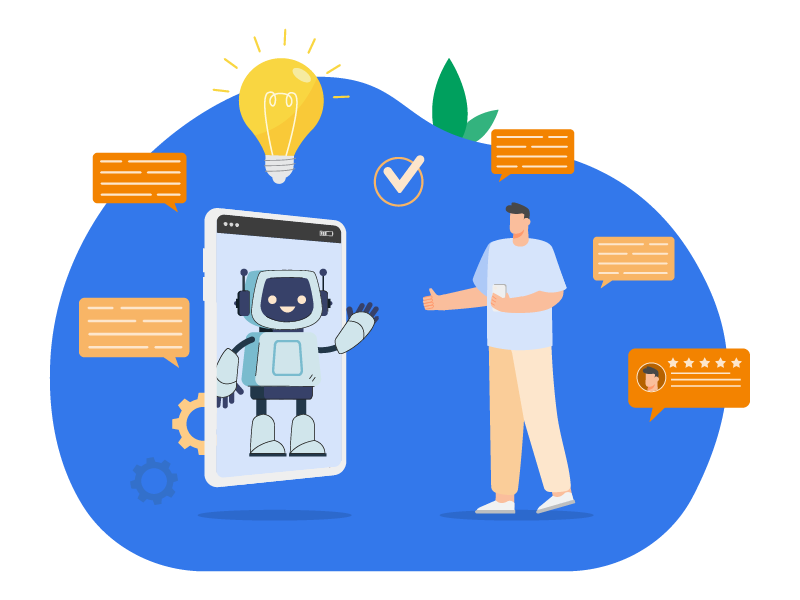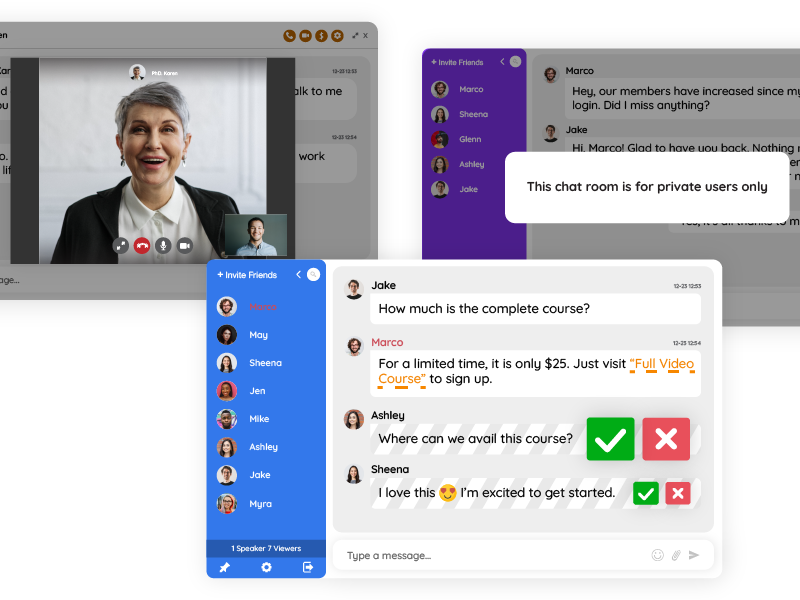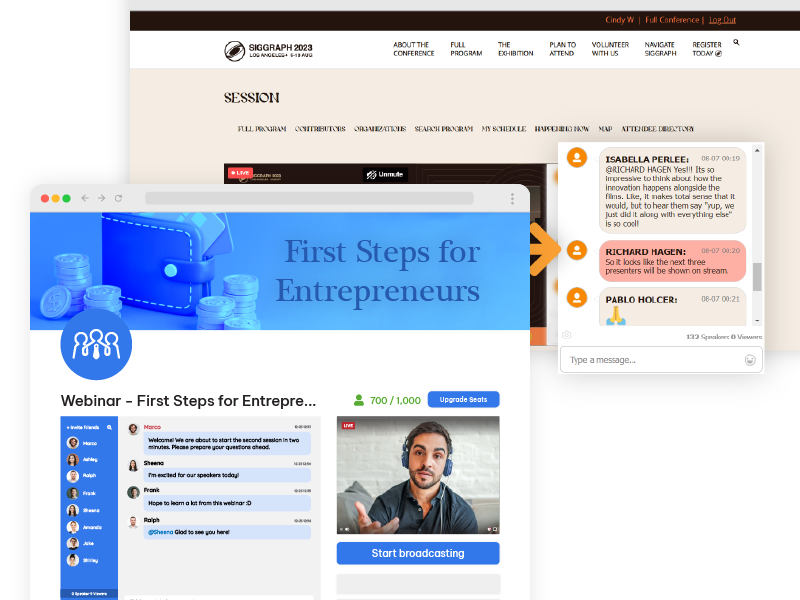Chatrooms have evolved significantly, catering to various purposes and preferences. Whether you’re a business owner seeking efficient customer service solutions or an individual looking to connect with like-minded people, there are two distinct types of chatrooms to consider: AI chatroom vs social chatroom. Each has its unique features, benefits, and limitations.
In this blog post, we’ll explore the characteristics of both AI chatrooms and social chatrooms to help you make an informed choice that aligns with your specific needs.
Understanding AI Chatrooms

AI chatrooms, often powered by sophisticated chatbots and automation, are designed to facilitate interactions between users and artificial intelligence.
These chatrooms are primarily focused on providing automated responses, answering queries, and executing predefined tasks. The core functionality of AI chatrooms revolves around enhancing user experiences through personalized and efficient interactions.
AI chatrooms find widespread applications in various sectors, including customer service, technical support, and process automation. Businesses and organizations leverage AI chatrooms to:
- Offer 24/7 Support: AI chatbots can provide round-the-clock assistance, ensuring customers receive help whenever they need it.
- Scale Operations: AI chatrooms handle multiple inquiries simultaneously, reducing the need for extensive human involvement.
- Collect and Analyze Data: These chatrooms gather user data and insights, aiding businesses in making data-driven decisions.
- Streamline Processes: Automation within AI chatrooms can perform routine tasks, such as appointment scheduling or order tracking.
What about social chatrooms?
In contrast, social chatrooms primarily focus on real-time interactions among users. These chatrooms, often integrated into social media platforms and online communities, serve as spaces where individuals can engage in conversations, share multimedia content, and build social connections.
The functionality of social chatrooms centers on facilitating human interactions and community engagement.
Social chatrooms have diverse use cases and are commonly found on social media platforms, discussion forums, and networking websites. Individuals and social groups utilize social chatrooms for:
- Building Communities: Social chatrooms foster a sense of belonging and community among like-minded individuals.
- Instant Messaging: They provide a platform for friends and acquaintances to communicate in real time.
- Sharing Experiences: Users can share multimedia content, personal stories, and opinions with others.
- Networking: Professionals use social chatrooms for networking, job searching, and sharing industry-related insights.
Features and Capabilities
AI Chatroom Features
AI chatrooms are distinguished by their unique features, which include:
- Chatbots: These AI-driven agents engage with users, answer questions, and perform tasks autonomously.
- Automation: AI chatrooms automate repetitive processes, improving efficiency and response times.
- Personalization: They can offer personalized recommendations, content, and responses based on user data.
- Data Analysis: AI chatrooms collect and analyze user data to gain insights into user behavior and preferences.
Social Chatroom Features
On the other hand, social chatrooms offer a different set of features:
- User Profiles: Users typically have profiles with avatars and personal information.
- Real-Time Messaging: Conversations happen in real-time, making it ideal for synchronous interactions.
- Multimedia Sharing: Users can share images, videos, links, and other media within the chat.
- Emojis and Reactions: Social chatrooms often include emojis and reactions to express emotions and reactions.
Benefits and Limitations

Benefits of AI Chatrooms
AI chatrooms offer numerous advantages, including:
- 24/7 Availability: They provide continuous support and assistance without time constraints.
- Scalability: AI chatrooms handle multiple users simultaneously, making them suitable for growing businesses.
- Data-Driven Insights: They collect and analyze data, helping businesses make informed decisions.
- Efficiency: Automation streamlines processes, reducing response times and workload.
Limitations of AI Chatrooms
However, AI chatrooms may have limitations, such as:
- Limited Human Interaction: They lack the depth of human interactions, which can be a drawback in emotionally sensitive scenarios.
- Comprehension Challenges: AI chatbots may struggle to understand complex or nuanced queries, leading to frustrating user experiences.
- Not Ideal for All Scenarios: In situations requiring empathy or complex decision-making, AI chatrooms may not be the best choice.
Benefits of Social Chatrooms
Social chatrooms offer several benefits:
- Human Interaction: They provide a platform for authentic human-to-human interactions, fostering connections.
- Community Building: Social chatrooms create spaces where like-minded individuals can come together.
- Rich Media Sharing: Users can share diverse multimedia content, enhancing engagement.
- Personal Connections: Social chatrooms allow for personal connections and friendships to form.
Limitations of Social Chatrooms
Yet, social chatrooms have their limitations:
- Time-Consuming Interactions: Engaging in real-time conversations can be time-consuming, and users may find themselves distracted.
- Moderation Challenges: Maintaining a respectful and safe environment in social chatrooms can be challenging.
- May Not Suit All Needs: In situations where efficiency and automation are required, social chatrooms may not be the most suitable option.
AI chatroom vs social chatroom: use cases and examples
- E-commerce: Amazon
Use Case: Amazon, the world’s largest online retailer, employs AI chatbots to enhance its customer support and streamline user interactions.
How They Use It: Amazon’s chatbots assist customers with a wide range of tasks, including order tracking, product recommendations, and addressing common inquiries. This level of automation ensures that customers receive quick responses to their questions, contributing to a seamless shopping experience.
- Healthcare: Babylon Health
Use Case: Babylon Health, a telehealth platform, utilizes AI chatrooms to provide medical advice and support.
How They Use It: Babylon’s AI chatbot interacts with users, asks questions about their symptoms, and provides healthcare advice based on their responses. This chatbot helps users determine whether they need to see a doctor, ultimately improving healthcare access and efficiency.
- Finance: Bank of America
Use Case: Bank of America employs AI chatbots in its digital banking services.
How They Use It: Customers can use the bank’s chatbot, Erica, to perform various banking tasks, such as checking balances, transferring funds, and even receiving financial insights. Erica provides 24/7 support and enhances the overall banking experience.
- Education: Duolingo
Use Case: Duolingo, a language-learning platform, integrates AI chatrooms to offer personalized language lessons.
How They Use It: Duolingo’s chatbot engages users in conversations to improve their language skills. It tailors lessons to individual proficiency levels and helps learners practice speaking and comprehension.
Social Chatroom Use Cases
Social chatrooms are prevalent across different platforms and have various applications. Here are real-life examples of how businesses and individuals leverage social chatrooms:
- Social Media: Twitter
Use Case: Twitter incorporates real-time chat functionalities into its platform.
How They Use It: Users on Twitter engage in conversations using tweets and direct messages (DMs). This social chatroom allows individuals and businesses to interact with their followers, share updates, and respond to inquiries in real-time.
- Online Forums: Reddit
Use Case: Reddit, a vast online community, hosts discussion threads with real-time commenting.
How They Use It: Subreddits on Reddit serve as social chatrooms where users discuss a wide array of topics. Members can share their experiences, opinions, and advice, creating vibrant online communities.
- Chatroom Platforms: RumbleTalk
Use Case: RumbleTalk is a versatile chat platform used for creating social chatrooms on various websites and platforms.
How They Use It: Website owners and community managers integrate RumbleTalk’s chatrooms to foster real-time conversations among their users. It enables individuals and groups to engage in discussions, share multimedia content, and strengthen online communities.
- Networking Sites: LinkedIn
Use Case: LinkedIn, a professional networking site, incorporates messaging for networking purposes.
- How They Use It: LinkedIn’s messaging feature allows professionals to connect with one another, discuss job opportunities, share industry insights, and collaborate on projects. It serves as a social chatroom for business networking.
Making the Right Choice
When deciding between AI chatrooms vs social chatrooms, consider the following factors:
- Purpose: Determine the primary purpose of the chatroom. Is it for support, engagement, networking, or information dissemination?
- Audience: Identify the target audience and their preferences. Do they require automated assistance or value personal connections?
- Resources: Assess the resources available for implementation, including budget, technology, and human resources.
- Scalability: Consider whether the chatroom needs to accommodate growing user numbers.
- Moderation: Think about the level of moderation and management required for maintaining a safe environment.
AI Chatroom vs Social Chatroom: Which Is The Winner?
Both AI chatrooms and social chatrooms offer valuable features and benefits. In the battle between AI chatroom vs social chatroom, the choice depends on your specific needs and objectives. Whether you seek efficient automation or genuine human interactions, understanding the differences between these two chatroom types will help you make the right decision that suits your unique requirements.
If you’re leaning towards more on the social chatroom, you can sign up here to try one for free.




